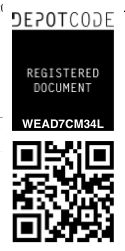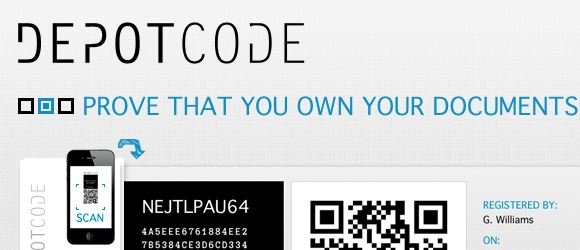DepotCode: Copyright Verification Through QR Codes
 The field of non-repudiation services is getting more and more crowded every week. From the long-running services like Numly to the current major players like Safe Creative and Myows, there are a lot of companies and services out there that let you register your work with them as a way to prove authorship or otherwise verify it by date, time and who claimed it.
The field of non-repudiation services is getting more and more crowded every week. From the long-running services like Numly to the current major players like Safe Creative and Myows, there are a lot of companies and services out there that let you register your work with them as a way to prove authorship or otherwise verify it by date, time and who claimed it.
Though none of these services are replacements for an official registration with the U.S. Copyright Office, which comes with it certain legal benefits in the U.S. they can provide a way to prove exactly when a work was created and who did so. This can prevent others from laying claim to it later.
However, the stiff competition has not stopped others from trying to find a niche within it. One service, DepotCode (Note: This link is to the beta page, going to depotcode.com will not work), hopes to break into the field with a new set of features and an easier-to-use interface that may be better for the casual user.
But does DepotCode hold up? I decided to give it a shot and see what I found.
What is DepotCode
The idea behind DepotCode is similar to other non-repudiation services. The user uploads a file and that file is registered on DepotCode’s servers. DepotCode then records the date, time and a hash of the file and then creates a page where others can then verify the work as long as the registration is active.
Unlike it’s competitors, registration is not required to use DepotCode, you simply click the button to sign your document, fill out your name, company and email information and then upload your document. DepotCode can accept text, images, PDFs and various programming/formatting languages, including Javascript, Ruby, PHP, Java, C#, HTML, XML, and CSS. Other documents can be signed but the signature will not appear on the document.
DepotCode’s most unique feature is that it automatically adds a QR code to PDFs and images that are uploaded. See below for an example (see note below):

The idea being that, if you want to share the image or the PDF, you simply send the one marked with the code (it’s marked on every page of a PDF) instead of a plain one. That way, others who get it can verify who owns/created it.
A free DepotCode registration lasts one week through a paid registration costs $ 3.49 (increasing to $6.99 after the beta period) and holds the registration for two years.
So should you be using DepotCode to protection your work? The answer depends on your situation and what you’re wanting to use it for.
The Good and Bad of DepotCode
On the surface, there’s a great deal to like about DepotCode. The ability to add QR codes to documents is interesting and, with QR codes readers becoming more common place, it might be a good idea for protecting content moving forward.
Also, the lack of a registration requirement is great for those who just want to register a file very quickly. It makes it easy to jump in and get started without worrying about setting up an account.
However, that lack of registration is also a bit of a hindrance. The beta version doesn’t have the ability to set up an account. So, every time you want to register something, you have to enter the same information over and over again. Other services make it easier to register works in bulk by storing that information.
Likewise, even the price is a bit odd. Other services provide free accounts with registrations that don’t expire (many free Numly registrations are still valid after five years or more), however, even a paid registration will expire after two years. While most works won’t need this kind of protection after two years, especially with the statute of limitations for copyright infringement being what it is, there are situations where a paid registration could expire before the dispute surfaces.
Finally, though the QR code feature is useful and interesting, other services offer it as well. Safe Creative offers a series of barcodes for each of its registrations, including QR codes and has done so for years. Numly has offered barcodes on all of its registrations for over five years now.
In short, the features that make DepotCode unique are that it applies the QR codes automatically, that it is designed to work with programming code and that there is no registration requirement. While certainly an interesting set of features, it may not be enough to overcome its bizarre pricing structure and the difficulties in registering large numbers of works.
Bottom Line
All of this begs the question of who is DepotCode for? Clearly the pricing and lack of registration makes it inappropriate for casual use. Services like Safe Creative and Myows are much better for bloggers who want to register all of their posts or photographers that want to upload every image they take.
The structure, right now, is best suited for anyone who wants to register just one or two things and would benefit from having the QR code placed directly on it. An author, for example, registering a PDF before sending it to potential publishers, might want to register through DepotCode as it could be worth a few dollars to save the time of applying the QR code themselves. The same could be true for programmers turning in a big project.
Outside of that though, the other systems out there are simply cheaper and offer less friction to registering large numbers of works. The QR code feature is interesting, but similar features never took off so it will probably remain a niche product, at least for the time being.
All in all, most people will benefit more from other services, but that could change if the use of QR codes for this purpose catches on and others fail to replicate the feature successfully.
The odds of that, unfortunately, are very slim.
Disclosure: I have done paid consulting for both Safe Creative and Myows.
Note: All of the registrations for this review were done using the free version, meaning the QR codes will cease to work in one week.
Want to Reuse or Republish this Content?
If you want to feature this article in your site, classroom or elsewhere, just let us know! We usually grant permission within 24 hours.
